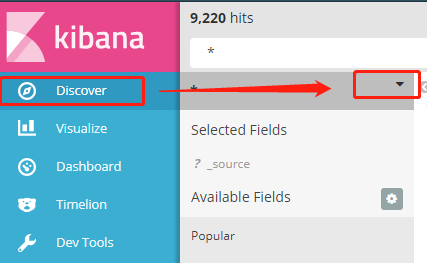目录
ELk(Elasticsearch, Logstash, Kibana)的安装配置
本文中所有的版本都是基于5.2.0,因为公司es(Elasticsearch)的环境是5.2.0。
1. Elasticsearch的安装-官网
关于Elasticsearch的安装在之前的文章中已经写过了,这里不再赘述。
[elasticsearch及head插件安装与配置](https://www.cnblogs.com/chaos-x/p/9446250.html)
2. Kibana的安装配置-官网
Kibana是一个能把你es中数据进行可视化显示的工具,包括实时统计和分析,基本上是零配置。
1. Kibana下载地址
Kibana 5.2.0 linux 64-bit tar.gz
wget https://artifacts.elastic.co/downloads/kibana/kibana-5.2.0-linux-x86_64.tar.gz
2.解压
tar -zxvf kibana-5.2.0-linux-x86_64.tar.gz
3. 配置
vim kibana-5.2.0-linux-x86_64/config/kibana.yml
# Kibana is served by a back end server. This setting specifies the port to use.
server.port: 30000
# Specifies the address to which the Kibana server will bind. IP addresses and host names are both valid values.
# The default is 'localhost', which usually means remote machines will not be able to connect.
# To allow connections from remote users, set this parameter to a non-loopback address.
server.host: "0.0.0.0"
# The URL of the Elasticsearch instance to use for all your queries.
# es的访问地址和商品号
elasticsearch.url: "http://localhost:19200"- 启动
sh kibana-5.2.0-linux-x86_64/bin/kibana
在浏览器中访问Kibana的服务器加端口号就可以看到Kibana的页面了。
3. Logstash的安装配置-官网
Logstash是日志的收集工具,可以对日志进行收集,分析,解码,过滤,输出。一般使用Filebeat收集日志到Logstash,由Logstash处理后保存到es。关于Filebeat后面再说。
1. 下载
https://artifacts.elastic.co/downloads/logstash/logstash-5.2.0.tar.gz
wget https://artifacts.elastic.co/downloads/logstash/logstash-5.2.0.tar.gz
2. 解压
tar -zxvf logstash-5.2.0.tar.gz
3. 启动
sh logstash-5.2.0/bin/logstash -e 'input{stdin{}}output{stdout{codec=>rubydebug}}'
启动后输入'hello word',回车。会输出如下结果
{
"message" => "Hello World",
"@version" => "1",
"@timestamp" => "2014-08-07T10:30:59.937Z",
"host" => "raochenlindeMacBook-Air.local",
}Logstash 会给事件添加一些额外信息。最重要的就是 @timestamp,用来标记事件的发生时间。因为这个字段涉及到 Logstash 的内部流转,所以必须是一个 joda 对象,如果你尝试自己给一个字符串字段重命名为 @timestamp 的话,Logstash 会直接报错。所以,请使用 filters/date 插件 来管理这个特殊字段。
4. 配置
可以把把配置写到一个文件中,来启动Logstash。
- 在Logstash的配置文件目录中创建
test.yml文件
cd logstash-5.2.0/config/
vim test.yml- 配置文件内容
input{
stdin{}
}
ouput{
stdout{
codec=>rubydebug
}
}启动
sh logstash-5.2.0/bin/logstash -f logstash-5.2.0/config/test.yml
可以达步骤3的效果。
4. 使用ELK收集nginx的访问日志
1.配置Logstash
- 在Logstash的配置文件目录中创建
nginx-log.yml文件
cd logstash-5.2.0/config/
vim nginx-log.yml- 配置文件内容
input {
file { # 指定一个文件作为输入源
path => "/usr/local/nginx/logs/access.log" # 指定文件的路径
start_position => "beginning" # 指定何时开始收集,这时设置从文件的最开头收集
type => "nginx" # 定义日志类型,可自定义
}
}
filter { # 配置过滤器
grok {
match => { "message" => "%{IPORHOST:http_host} %{IPORHOST:clientip} - %{USERNAME:remote_user} \[%{HTTPDATE:timestamp}\] \"(?:%{WORD:http_verb} %{NOTSPACE:http_request}(?: HTTP/%{NUMBER:http_version})?|%{DATA:raw_http_request})\" %{NUMBER:response} (?:%{NUMBER:bytes_read}|-) %{QS:referrer} %{QS:agent} %{QS:xforwardedfor} %{NUMBER:request_time:float}"} # 定义日志的输出格式
}
geoip {
source => "clientip"
}
}
output {
# 标准输出,是输出到终端
stdout { codec => rubydebug }
# 输出到es
elasticsearch {
hosts => ["127.0.0.1:19200"]
index => "nginx-log-%{+YYYY.MM.dd}"
}
}- 检查配置文件
sh logstash --path.settings /etc/logstash/ -f logstash-5.2.0/config/nginx-log.yml --config.test_and_exit
2. 配置nginx的配置文件
- 打开nginx的配置文件
vim /usr/local/nginx/conf/nginx.conf
- 在http中增加如下内容
http {
include mime.types;
default_type application/octet-stream;
#log_format main '$remote_addr - $remote_user [$time_local] "$request" '
# '$status $body_bytes_sent "$http_referer" '
# '"$http_user_agent" "$http_x_forwarded_for"';
log_format main2 '$http_host $remote_addr - $remote_user [$time_local] "$request" '
'$status $body_bytes_sent "$http_referer" '
'"$http_user_agent" "$upstream_addr" $request_time';
}- 在要格式化日志的 server中增加如下配置
#access_log logs/host.access.log main;
# 增加如下内容, 日志格式化main2要在上面定义,不然这里无法引用
access_log logs/elk_access.log main2;
location / {
root html;
index index.html index.htm;
# 增加如下三行内容,分别是携带访问host,远程地址和各层代理地址
proxy_set_header Host $host;
proxy_set_header X-Real-IP $remote_addr;
proxy_set_header X-Forwarded-For $proxy_add_x_forwarded_for;
}- 重启nginx
sh /usr/local/nginx/sbin/nginx -s reload
3. 检查启动
检查
sh logstash-5.2.0/bin/logstash -f logstash-5.2.0/config/nginx-log.yml --config.test_and_exit启动
sh logstash-5.2.0/bin/logstash -f logstash-5.2.0/config/nginx-log.yml
当终端输出如下内容就成功了
{
"@timestamp" => 2018-12-18T08:44:56.361Z,
"plugin_instance" => "vda",
"read" => 467266,
"plugin" => "disk",
"host" => "172.24.121.18",
"@version" => "1",
"collectd_type" => "disk_ops",
"type" => "collectd",
"write" => 12204609
}
{
"longterm" => 0.08,
"@timestamp" => 2018-12-18T08:44:46.362Z,
"plugin" => "load",
"shortterm" => 0.06,
"host" => "172.24.121.18",
"@version" => "1",
"collectd_type" => "load",
"type" => "collectd",
"midterm" => 0.04
}5. Kibana展示nginx访问日志
进入Kibana页面如下

- 配置Index Patterns

- 进入后点击左上角的 ‘add new’ 进行创建索引模板
在Kibana中,要分析展示数据时,要先创建Index Patterns

选择index的时候可以用通配符 ‘*’ 来把所有的nginx-log的访问日志分成一个组。
Time-field name 是要指定一个日期格式的字段,以便于后面统计使用。

然后就可以在这里选择配置好的Index patterns了。

其中x轴的时间就是创建Index Patterns的时候选择的那个日期字段。
参考:
- http://blog.51cto.com/zero01/2082794
- https://doc.yonyoucloud.com/doc/logstash-best-practice-cn/input/stdin.html
---恢复内容结束---
本文中所有的版本都是基于5.2.0,因为公司es(Elasticsearch)的环境是5.2.0。
1. Elasticsearch的安装-官网
关于Elasticsearch的安装在之前的文章中已经写过了,这里不再赘述。
[elasticsearch及head插件安装与配置](https://www.cnblogs.com/chaos-x/p/9446250.html)
2. Kibana的安装配置-官网
Kibana是一个能把你es中数据进行可视化显示的工具,包括实时统计和分析,基本上是零配置。
1. Kibana下载地址
Kibana 5.2.0 linux 64-bit tar.gz
wget https://artifacts.elastic.co/downloads/kibana/kibana-5.2.0-linux-x86_64.tar.gz
2.解压
tar -zxvf kibana-5.2.0-linux-x86_64.tar.gz
3. 配置
vim kibana-5.2.0-linux-x86_64/config/kibana.yml
# Kibana is served by a back end server. This setting specifies the port to use.
server.port: 30000
# Specifies the address to which the Kibana server will bind. IP addresses and host names are both valid values.
# The default is 'localhost', which usually means remote machines will not be able to connect.
# To allow connections from remote users, set this parameter to a non-loopback address.
server.host: "0.0.0.0"
# The URL of the Elasticsearch instance to use for all your queries.
# es的访问地址和商品号
elasticsearch.url: "http://localhost:19200"- 启动
sh kibana-5.2.0-linux-x86_64/bin/kibana
在浏览器中访问Kibana的服务器加端口号就可以看到Kibana的页面了。
3. Logstash的安装配置-官网
Logstash是日志的收集工具,可以对日志进行收集,分析,解码,过滤,输出。一般使用Filebeat收集日志到Logstash,由Logstash处理后保存到es。关于Filebeat后面再说。
1. 下载
https://artifacts.elastic.co/downloads/logstash/logstash-5.2.0.tar.gz
wget https://artifacts.elastic.co/downloads/logstash/logstash-5.2.0.tar.gz
2. 解压
tar -zxvf logstash-5.2.0.tar.gz
3. 启动
sh logstash-5.2.0/bin/logstash -e 'input{stdin{}}output{stdout{codec=>rubydebug}}'
启动后输入'hello word',回车。会输出如下结果
{
"message" => "Hello World",
"@version" => "1",
"@timestamp" => "2014-08-07T10:30:59.937Z",
"host" => "raochenlindeMacBook-Air.local",
}Logstash 会给事件添加一些额外信息。最重要的就是 @timestamp,用来标记事件的发生时间。因为这个字段涉及到 Logstash 的内部流转,所以必须是一个 joda 对象,如果你尝试自己给一个字符串字段重命名为 @timestamp 的话,Logstash 会直接报错。所以,请使用 filters/date 插件 来管理这个特殊字段。
4. 配置
可以把把配置写到一个文件中,来启动Logstash。
- 在Logstash的配置文件目录中创建
test.yml文件
cd logstash-5.2.0/config/
vim test.yml- 配置文件内容
input{
stdin{}
}
ouput{
stdout{
codec=>rubydebug
}
}启动
sh logstash-5.2.0/bin/logstash -f logstash-5.2.0/config/test.yml
可以达步骤3的效果。
4. 使用ELK收集nginx的访问日志
1.配置Logstash
- 在Logstash的配置文件目录中创建
nginx-log.yml文件
cd logstash-5.2.0/config/
vim nginx-log.yml- 配置文件内容
input {
file { # 指定一个文件作为输入源
path => "/usr/local/nginx/logs/access.log" # 指定文件的路径
start_position => "beginning" # 指定何时开始收集,这时设置从文件的最开头收集
type => "nginx" # 定义日志类型,可自定义
}
}
filter { # 配置过滤器
grok {
match => { "message" => "%{IPORHOST:http_host} %{IPORHOST:clientip} - %{USERNAME:remote_user} \[%{HTTPDATE:timestamp}\] \"(?:%{WORD:http_verb} %{NOTSPACE:http_request}(?: HTTP/%{NUMBER:http_version})?|%{DATA:raw_http_request})\" %{NUMBER:response} (?:%{NUMBER:bytes_read}|-) %{QS:referrer} %{QS:agent} %{QS:xforwardedfor} %{NUMBER:request_time:float}"} # 定义日志的输出格式
}
geoip {
source => "clientip"
}
}
output {
# 标准输出,是输出到终端
stdout { codec => rubydebug }
# 输出到es
elasticsearch {
hosts => ["127.0.0.1:19200"]
index => "nginx-log-%{+YYYY.MM.dd}"
}
}- 检查配置文件
sh logstash --path.settings /etc/logstash/ -f logstash-5.2.0/config/nginx-log.yml --config.test_and_exit
2. 配置nginx的配置文件
- 打开nginx的配置文件
vim /usr/local/nginx/conf/nginx.conf
- 在http中增加如下内容
http {
include mime.types;
default_type application/octet-stream;
#log_format main '$remote_addr - $remote_user [$time_local] "$request" '
# '$status $body_bytes_sent "$http_referer" '
# '"$http_user_agent" "$http_x_forwarded_for"';
log_format main2 '$http_host $remote_addr - $remote_user [$time_local] "$request" '
'$status $body_bytes_sent "$http_referer" '
'"$http_user_agent" "$upstream_addr" $request_time';
}- 在要格式化日志的 server中增加如下配置
#access_log logs/host.access.log main;
# 增加如下内容, 日志格式化main2要在上面定义,不然这里无法引用
access_log logs/elk_access.log main2;
location / {
root html;
index index.html index.htm;
# 增加如下三行内容,分别是携带访问host,远程地址和各层代理地址
proxy_set_header Host $host;
proxy_set_header X-Real-IP $remote_addr;
proxy_set_header X-Forwarded-For $proxy_add_x_forwarded_for;
}- 重启nginx
sh /usr/local/nginx/sbin/nginx -s reload
3. 检查启动
检查
sh logstash-5.2.0/bin/logstash -f logstash-5.2.0/config/nginx-log.yml --config.test_and_exit启动
sh logstash-5.2.0/bin/logstash -f logstash-5.2.0/config/nginx-log.yml
当终端输出如下内容就成功了
{
"@timestamp" => 2018-12-18T08:44:56.361Z,
"plugin_instance" => "vda",
"read" => 467266,
"plugin" => "disk",
"host" => "172.24.121.18",
"@version" => "1",
"collectd_type" => "disk_ops",
"type" => "collectd",
"write" => 12204609
}
{
"longterm" => 0.08,
"@timestamp" => 2018-12-18T08:44:46.362Z,
"plugin" => "load",
"shortterm" => 0.06,
"host" => "172.24.121.18",
"@version" => "1",
"collectd_type" => "load",
"type" => "collectd",
"midterm" => 0.04
}5. Kibana展示nginx访问日志
进入Kibana页面如下

- 配置Index Patterns

- 进入后点击左上角的 ‘add new’ 进行创建索引模板
在Kibana中,要分析展示数据时,要先创建Index Patterns

选择index的时候可以用通配符 ‘*’ 来把所有的nginx-log的访问日志分成一个组。
Time-field name 是要指定一个日期格式的字段,以便于后面统计使用。

然后就可以在这里选择配置好的Index patterns了。

其中x轴的时间就是创建Index Patterns的时候选择的那个日期字段。
参考: